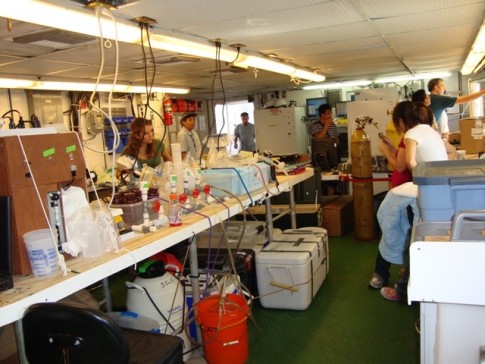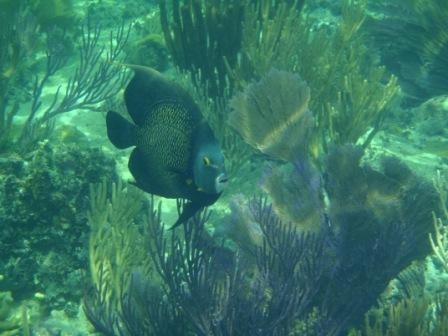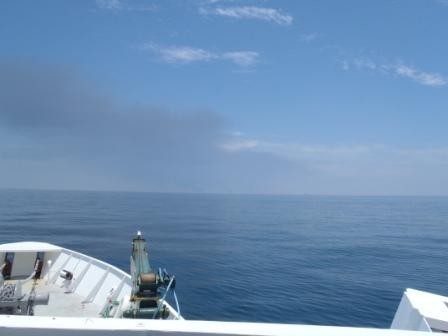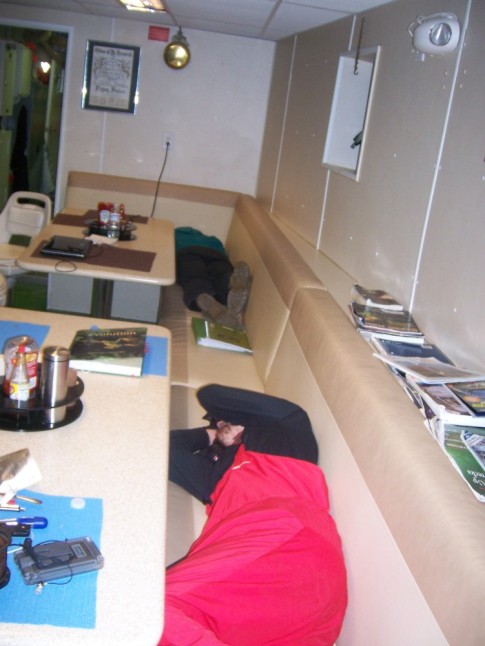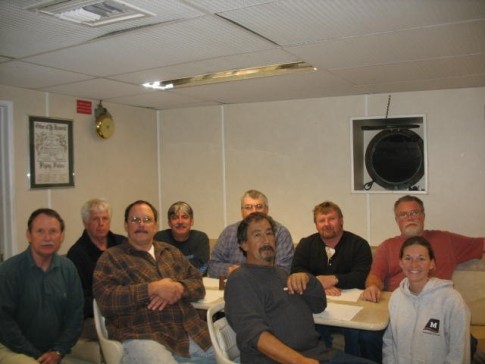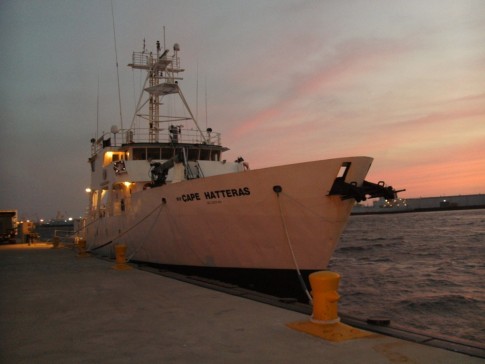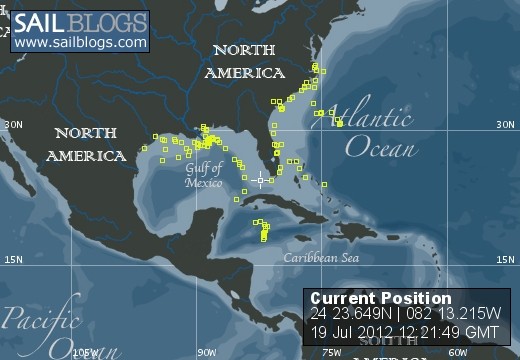
Research Vessel Cape Hatteras
The R/V CAPE HATTERAS is owned by the National Science Foundation and operated under a renewable Charter Party Agreement by the Duke/UNC Oceanographic Consortium. Her homeport is at Duke University Marine Laboratory in Beaufort, North Carolina.
11 March 2013
01 February 2013 | Beaufort, NC
14 January 2013
14 January 2013
19 July 2012 | Straits of Florida
19 July 2012
04 July 2012
15 November 2011 | East Flower Garden Banks, Gulf of Mexico
06 November 2011 | East Flower Garden Back, Gulf of Mexico
05 November 2011 | Gulf of Mexico
27 August 2011 | North Charleston, SC
26 August 2011 | North Charleston, SC
25 August 2011 | off SC coast
23 August 2011 | off the coast of NC
23 August 2011 | Off the coast of NC
06 August 2011 | Gulf of Mexico
05 August 2011 | GUlf of Mexico
30 June 2011 | Gulf of Mexico
30 June 2011 | Charleston, SC
25 May 2011 | Mission Annelid: Success
Cruise Update
16 October 2010 | Ground Zero
Patrick and Noah

"Catch of the Day"... loaded with Omega-3 fatty acids!
Day 6 of our cruise on the Gulf of Mexico and we've reached "ground zero" of the Deep Water Horizon oil spill (see picture link). So far, the weather is holding and the sea is almost as calm as a lake. A far cry from the Arctic/sub Arctic cruises I sailed on some 15-20 years ago. Another oddity, to me at least, is the connectedness one feels now on modern cruises. Beyond the Wi-Fi email access (slow but steady), we now enjoy satellite TV! I can proudly say I watched my London-based soccer team win its Saturday match live in the middle of the sea. But that's hardly relevant to science, is it? Well, it sort of is. If we're not blind (and deaf) to the human world, we're less and less so to the natural one as well. Not so long ago, we chose water depths for sampling based exclusively on water masses derived from salinity/temperature profiles. And that was after download of the data stored in the CTD once it was brought back on deck. Today, we not only monitor salinity and temperature in real time, but we also carry a whole suite of sensors that measure other chemical properties. Choosing a water depth to sample is as easy as reading a graph on the lab computer. It takes some of the guessing out of science. In this trip, for example, we are using several fluorescence probes to detect the potential presence of hydrocarbons (from the oil spill) in the water column. And we are observing interesting "features" at depths (around 1000-1300 m) previously identified as an oil plume by prior research cruises. We also have a cavity ring-down spectrometer on board, one of the coolest instruments to hit the analytical tool kit in recent years. Dr. Alan Schiller (University of Southern Mississippi) is measuring methane with this instrument and lifting even more the "blindfolds" usually associated with fieldwork research. We have found some methane in the water column as well as definite evidence of fresh oil at the surface of sediments (see the picture of fluorescing oil droplets under black light). Granted, we will still have to wait months for all the data to make its way into our spreadsheets, emails and eventually into conference talks and scientific papers. It will take me that long to measure the hydrocarbon concentrations and chemical signatures from just a subset of all the sediment and water samples we are bringing back. For all its gadgets, seeking to shrink the time it takes to produce data, science and in particular ocean research, is still a process of delayed gratification... Though sometimes, when the results we get are not what we anticipated, it can become a process of delayed frustration. In anticipation of the long hours in the lab producing towards some answers, we might enjoy ourselves now, in our pretense of isolation. It's so pretty out here; I can't but feel a sense of elation at being part of this. And this year is particularly special for me since I get to do this with my son, Noah.
Day 6 of our cruise on the Gulf of Mexico and we've reached "ground zero" of the Deep Water Horizon oil spill (see picture link). So far, the weather is holding and the sea is almost as calm as a lake. A far cry from the Arctic/sub Arctic cruises I sailed on some 15-20 years ago. Another oddity, to me at least, is the connectedness one feels now on modern cruises. Beyond the Wi-Fi email access (slow but steady), we now enjoy satellite TV! I can proudly say I watched my London-based soccer team win its Saturday match live in the middle of the sea. But that's hardly relevant to science, is it? Well, it sort of is. If we're not blind (and deaf) to the human world, we're less and less so to the natural one as well. Not so long ago, we chose water depths for sampling based exclusively on water masses derived from salinity/temperature profiles. And that was after download of the data stored in the CTD once it was brought back on deck. Today, we not only monitor salinity and temperature in real time, but we also carry a whole suite of sensors that measure other chemical properties. Choosing a water depth to sample is as easy as reading a graph on the lab computer. It takes some of the guessing out of science. In this trip, for example, we are using several fluorescence probes to detect the potential presence of hydrocarbons (from the oil spill) in the water column. And we are observing interesting "features" at depths (around 1000-1300 m) previously identified as an oil plume by prior research cruises. We also have a cavity ring-down spectrometer on board, one of the coolest instruments to hit the analytical tool kit in recent years. Dr. Alan Schiller (University of Southern Mississippi) is measuring methane with this instrument and lifting even more the "blindfolds" usually associated with fieldwork research. We have found some methane in the water column as well as definite evidence of fresh oil at the surface of sediments (see the picture of fluorescing oil droplets under black light). Granted, we will still have to wait months for all the data to make its way into our spreadsheets, emails and eventually into conference talks and scientific papers. It will take me that long to measure the hydrocarbon concentrations and chemical signatures from just a subset of all the sediment and water samples we are bringing back. For all its gadgets, seeking to shrink the time it takes to produce data, science and in particular ocean research, is still a process of delayed gratification... Though sometimes, when the results we get are not what we anticipated, it can become a process of delayed frustration. In anticipation of the long hours in the lab producing towards some answers, we might enjoy ourselves now, in our pretense of isolation. It's so pretty out here; I can't but feel a sense of elation at being part of this. And this year is particularly special for me since I get to do this with my son, Noah.
Comments
| Vessel Name: | R/V Cape Hatteras |
| Hailing Port: | Beaufort, NC |
| Extra: | |
| Home Page: | www.rvcapehatteras.org |

Port: Beaufort, NC
